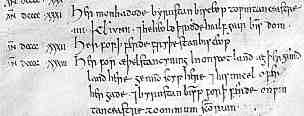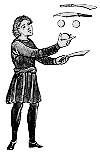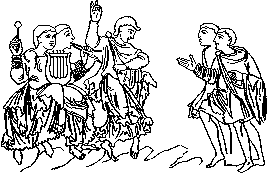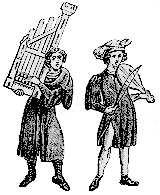






If you are looking at this page without frames, there is more information about medieval writing to be found by going to the home page (framed) or the site map (no frames).
| The Laity (2) | |||||
| Literacy was reintroduced to Britain through the church, and as elsewhere, this represented Latin literacy, largely confined to monastic communities and the clergy. During the reign of Alfred the Great, in the late 9th century when the Anglo-Saxon communities of the south had united against the invasions of the Danes in the north, some major works were translated into Old English. This revaluation of the vernacular as a language of literacy might suggest a spread of literacy beyond the cloister, or it might represent a political statement of ethnicity, the use of language being symbolic rather than useful. | |||||
 |
|||||
| A segment from a 10th century copy of The Universal History of Orosius in old English, supposedly translated or paraphrased from the Latin by King Alfred the Great, now in the British Library. (From New Palaeographical Society 1910) | |||||
| The example above represents an early Christian work translated from the Latin, like others of its time. The clericus or litteratus knew this work in Latin. Was this an attempt to spread literacy to the laity, or an attempt to Anglicise the church? | |||||
| The Anglo-Saxon Chronicle is a work of historical recording which was written in Old English as its original language. There are various different versions as the core text was continued in several different monastic scriptoria. Despite the language and its secular subject matter, its pedigree is in religious houses. |
 |
||||
| A segment from the version of the Anglo-Saxon Chronicle known as the A text (Cambridge, Corpus Christi College, MS 173). Down the left are the dates (931 to 933 shown here), with the text beside them. (From New Palaeographical Society 1908) | |||||
| It may have crossed your mind that, even if you can make anything of the script in these examples, there is not a single word that you can recognise from the English that you know and love. English has not only undergone enormous changes over the centuries, at this time it was not even a single language, rather a series of local dialects which in some cases were probably mutually incomprehensible. Literate usage promotes conformity in a language, and at this date the language of the laity in England was highly diverse. | |||||
| The jury is still out on the degree to which members of the wealthy or aristocratic laity of Anglo-Saxon England may have had literacy skills. They made wills, but like charters these were probably more in the way of insignia of witnessed oral testimony, dutifully written out by clerical scribes as a token of the event. There are rare surviving manuscripts of works derived from oral tradition, as with Beowulf. There is vernacular poetry. These things survive as odd manuscripts, and it is impossible to know what they represent in terms of a corpus of works now eternally lost. Furthermore, things written down from lay tradition were not necessarily written down by or even for the laity. An oral culture has its own means of preserving its traditions. |  |
 |
|||
| One enigmatic fragment hints at another whole class of written documentation which is otherwise completely lost from this era. A collection of rough notes relating to farming affairs from the early 11th century has been reassembled from three re-used and separated fragments (British Library, add ms 61735). However, as evidence for literacy in the agricultural sector as opposed to the clerical sphere, this little hint again leaves us in doubt, as the farms in question belonged to Ely Abbey. | |||||
 |
|||||
 |
I have a funny suspicion that any desire to ascribe literacy to the Anglo-saxon aristocracy springs from our own mental template which associates knowledge and culture with literacy. A rich culture full of song, story and poetry, with socially prescribed means of conducting its affairs, with knowledge of agriculture, business and trade is hard for us to imagine without a basis in writing. Ferret out the kind of ancient textbooks from which the illustrations on this page have been garnered and you will find illiteracy equated with ignorance and squalor. Perhaps we need to stretch our imaginations to encompass a culture based on remembering and trust in the integrity of the words of our fellows. | ||||
| Meanwhile, back in the main story, it is now 1066. | |||||
 |
Segment from the Bayeux Tapestry. | ||||
| William the Conqueror arrived in England and proceeded to reorganise the whole show. An illegitimate but aristocratic descendant of the Vikings who had rapidly adopted French ways in Normandy, he was most likely illiterate. He brought with him a crowd of aristocrats who spoke French to dominate the countryside. He brought his own bishops who were literate in Latin. English was relegated to the language of the lower classes and would have to wait a while longer to re-emerge as a language of literacy. | |||||
|
|
|||||
|
|
|||||
|
If you are looking at this page without frames, there is more information about medieval writing to be found by going to the home page (framed) or the site map (no frames). |
|||||